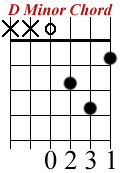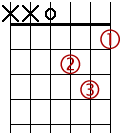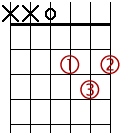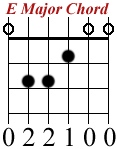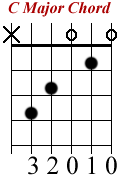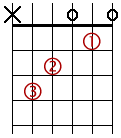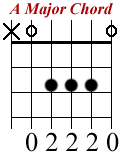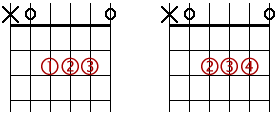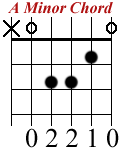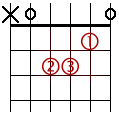Open Chords
In this post we’re going to look at open guitar chords. Chords are formed by placing your fingers on one more frets and strumming the guitar. Open guitar chords are the most basic and fundamental of everything you learn when you start off learning to play a guitar . This is definitely the first thing every guitarist should learn because it is the foundation for so many songs, you would be surprised how many really popular songs are just three open chords. I have to warn you though, they are not easy to play. It takes a lot of time and a lot of practice to be able to play well and change between them quickly. It seems tough at first but keep playing and eventually it becomes much easier until you can play them and switch between them without even looking at the guitar.
The best advice to start off with is to put your fingers into these positions and playing the chord, play it once, play it twice and get a feel for it, and try to keep your fingers away from the other string that way you can minimize any additional noise. This will definitely take some practice. Chords like C, E, Em, A, Am and Dm aren’t too bad and it shouldn’t take you too long to get used to them. Just remember, practice is everything.
When you are eventually used to playing some of these chords, find some easy guitar songs and try playing along or just strumming as practice.
Learn guitar chords (Major):
The C Major Chord
formed x32010
The E Major Chord
formed 022100
The A Major Chord
formed x02220
The G Major Chord
formed 320003 or 320033
The D Major Chord
formed xx0232
Learn guitar chords (minor):
The E Minor Chord
formed 022000
The A Minor Chord
formed x02210
The D Minor Chord
formed xx0231
The D Minor Chord
Here is how the D minor chord is formed:
Here are the proper finger positions:
The D Major Chord
The D major chord is formed as shown below
Here are the proper finger positions:
The E Major Chord
Now we’re looking at the E major chord. These are the notes you have to hold:
Now the actual finger positions:
The C Major Chord
One my favorite chords is the C major chord and these are the notes you hold.
And these are the proper finger positions.
The E Minor Chord
This is the E minor chord, these are the notes you have to hold:
Finger positions for the E minor chord are shown below
The A Major Chord
Here’s how you form the A major chord, its just three fingers as illustrated below:
The proper finger positions to use for the A major chord are below. The method you choose will depend ultimately on your fingers and hands.
The A Minor Chord
Here’s how you hold the A minor chord, this is one of the more popular chords and is actually quite easy to hold.
Here are the proper finger positions:
The Pull-Off
The pull-off is one of the most widely used techniques for soloing. It is very simple and can be applied in many different ways to many different situations. It is the exact opposite of the hammer-on, but requires a slight modification of technique. A pull-off is indicated in tab notation by this symbol:
+ + e:---------| B:-----6p4-| G:---------| D:-7p5-----| A:---------| E:---------|
The first pull-off is played on the 4th string from the 7th fret to the 5th fret.
The second pull-off is played on the 2nd string from the 6th fret to the 4th fret.
The pull-off’s shown above are accomplished by fretting both notes: the higher note with your ring finger and the lower note with your index finger. You then pick the note (and the higher note should sound), and release your ring finger quickly. The string should sound on the lower note after you have released the top finger. This is the most important part of the pull-off: making sure you fret both notes initially, and then making sure that you pull-off quickly enough that the lower note still sounds. You can also pull-off with different fingers, and you can work on this as you get better at them.
Other fingers can be used in the pull-off. Let’s try to play this example:
+ + e:---------| B:---------| G:-8p7-----| D:-----9p7-| A:---------| E:---------|
For the first, use your index finger to fret the third string 7th fret, and your middle finger to pull-off the 8th fret. For the second, simply move your index finger down a string to the fourth string 7th fret, and pull-off with your ring finger.
That’s about it for the pull-off. They are easy to perform, but do take some practice. The hardest parts are making sure you fret both fingers and that you pull-off quickly enough so that the lower note still sounds. Make sure you try pulling off with other fingers, because this versatility is required when performing complex solos later. Good luck with this new technique!
The G Major Chord
This is how the G major chord is formed. Each way is equal so it will just depend on your fingers and what feels comfortable for you.
The proper fingers to use for the G major chord are shown below.


